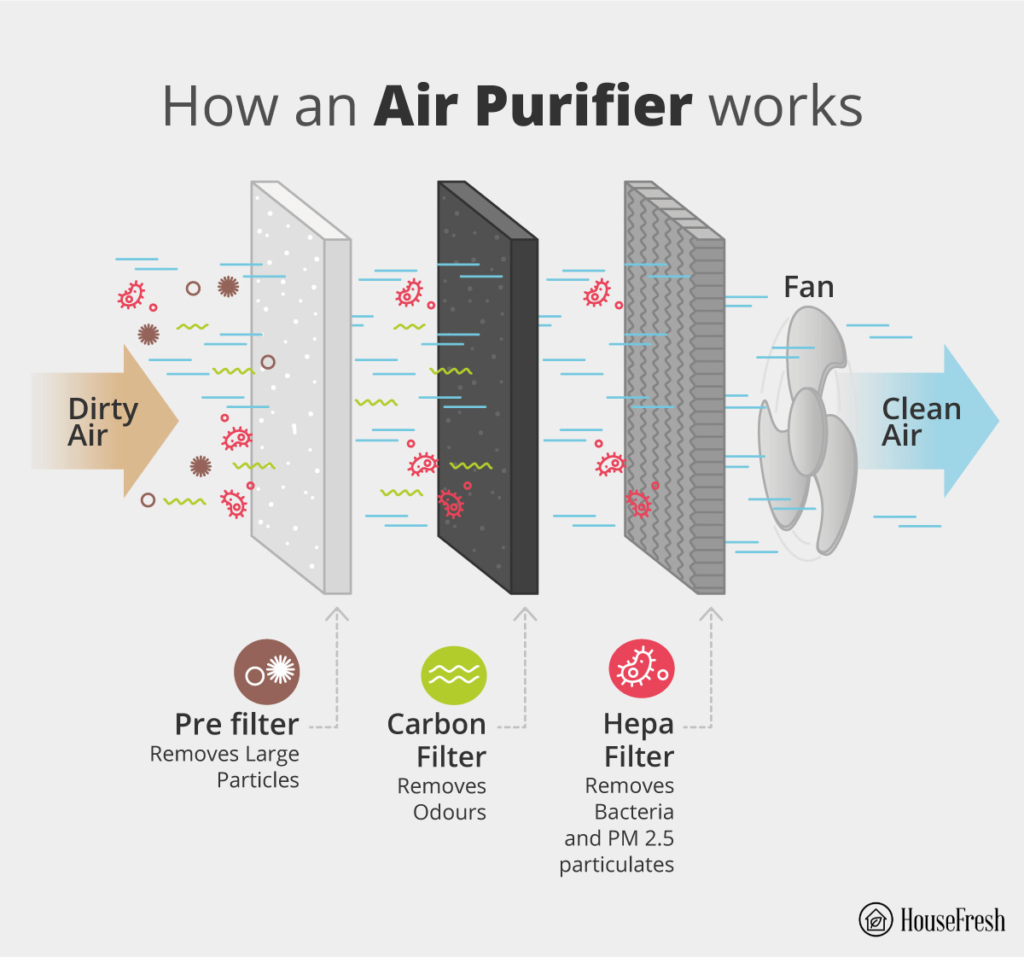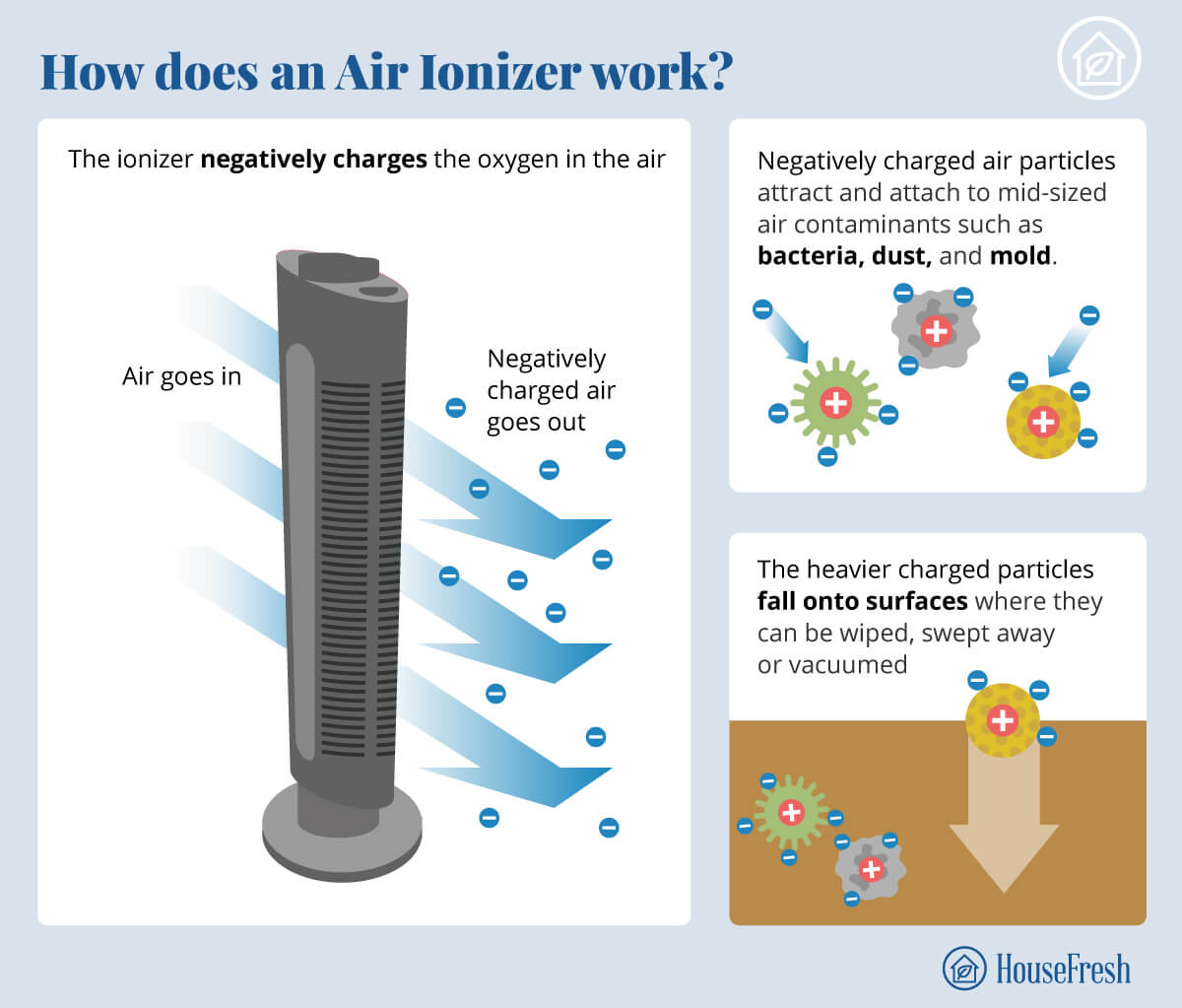It’s widely known that the air inside our homes contains pollutants of all sorts. From dust, pollen, pet dander, and mold spores (all allergy triggers) to viruses, bacteria, and volatile organic compounds (VOCs). The greater our understanding of indoor air pollution, the more popular air purifiers become.
These appliances are an effective solution to deal with pesky contaminants, especially when ventilation proves insufficient or when unable to remove the source of pollutants, like when living next to a busy road.
On top of all that, there are so many devices and technologies on the market that make things super confusing.
Purely mechanical air purifiers (HEPA and activated carbon filters) and electronic air cleaners (ionizers) have the same function: they remove airborne pollutants. But their mechanisms differ greatly — and so do their cleaning capabilities.
In a nutshell:
- Mechanical air purifiers use a fan to pull in air, pass it through the HEPA and activated carbon filters that trap the pollutants, and release a clean airflow into your space.
- Ionizers release an electrostatic discharge into the air that alters the particles’ structure, which forces them to drop out of the air.
The key differences between an air purifier and an ionizer
While both types of air cleaners may look similar from the outside, their mechanisms are nothing alike. Let’s find out why.
1. Air purifiers trap airborne pollutants through filtration and adsorption
As briefly explained above, mechanical purifiers pull the air from the environment and pass it through their filters before releasing clean air. Filters are made of different fibrous media, meaning they can trap pollutants on their surface.

As shown in the illustration, most mechanical air purifiers have a three-stage filtration process: a pre-filter, an activated carbon filter, and a HEPA (or HEPA-type) filter. Each stage tackles different types and sizes of contaminants.
Pre-filter: The first layer of protection. It prevents large particles (such as lint, coarse dust, or hair) from getting to the main filter. Prefilters need regular cleaning and upkeep to maintain efficiency.
Activated carbon: This layer tackles pollutants in their gas form. The carbon adsorbs odors, VOCs, and other toxic fumes, which get trapped on the porous surface of the charcoal, making them unable to reenter the air.
HEPA (high-efficiency particulate air) filter: This main filter is made of randomly assorted fine fibers in the form of pleated sheets. It’s constructed like a maze to capture even the tiniest particles (as small as 0.1 microns) like smoke. When the airflow passes through the filter, over 99% of fine particles get tangled in the fibers, accumulating on the filter’s surface.
Just like with HEPA filters, gaseous pollutants accumulate on the activated carbon’s surface. So, the bigger the surface area, the longer the filter will last to remain efficient at removing VOCs and odors.
Not all air purifiers have an activated carbon filter — some have a carbon-impregnated fiber. The best ones have charcoal pellets and are capable of adsorbing larger amounts of harmful fumes or unwanted smells.
2. Ionizers induce particle deposition but don’t trap pollutants.
Although ionizers do remove particles from the airstream, they don’t collect them.
As the name suggests, ion generators use imperceptible electrical discharges to release ions into the air. Some devices produce only negative ions and are known as unipolar ionizers. Bipolar ionizers, on the other hand, produce and release both positive and negative ions. Despite this difference, they use the same principle: electrically charging pollutants to force them to drop from the airstream.
The ions become airborne in air or water vapor molecules, which are then attracted to oppositely charged pollutants, such as bacteria, mold spores, and other small to mid-sized particles that inhabit our indoor air. These clusters of ions, attached to pollutants, become heavier and fall down, depositing on oppositely charged surfaces around us: furnishings, curtains, beds, couches, tabletops, walls, or floors.

Once the clusters land on these surfaces, they’ll stay there for some time, which you can vacuum or sweep. In fact, when using an ionizer, you’ll probably see more dust deposits around. Be mindful, however, that you’ll have to remove them periodically before the clusters break apart and the particles become airborne again.
ESPs and ionizers are often found under the same category: electronic air cleaners. Both technologies use an electrostatic process to charge and remove pollutants from the air.
However, ESP units have built-in oppositely charged plates that collect the heavily charged particles by pulling air into the device.
In contrast, ionizers only release negative ions into the air, altering the particles that then linger in your living space until you remove them. And still, they can easily disperse. Even vacuuming could disturb and resuspend them.
3. Ionizers produce potentially dangerous by-products. HEPA and activated carbon are harmless
One huge downside of ionizers is that they generate harmful by-products. The electrical discharges and artificial introduction of ions into the environment produce multiple chemical reactions besides particle deposition. They can alter molecules in our homes, turning them into toxic fumes such as ozone, acetone, ethanol, toluene, and aldehydes.
CARB has tested many ionizers, and the agency found them to produce ozone concentrations as low as 0.05 parts per million (the maximum ozone level set by the FDA). However, the EPA states that, even at those levels, ozone can react with common household chemicals. Fumes from cleaning products, polishes, and wood flooring, among others, can react with ozone and produce further VOCs.
But that’s not all. Ozone can also react with compounds such as terpene, found in air fresheners, and create ultrafine particles, adding secondary harmful aerosols instead of removing them.
Now, when it comes to mechanical air purifiers, both HEPA filters and activated carbon are harmless — they produce zero by-products. These devices operate with one goal in mind: to remove pollutants from your environment.
4. Research backs HEPA filters, but the verdict is still out there for ionizers.
HEPA filters were developed during World War II to control the spread of radioactive pollutants and remove them from the air. Since then, they’ve evolved into the commercial filters we now know, used in an array of air cleaners. Their filtering mechanism, however, remains pretty much the same.
Performance-wise, filters must meet strict quality standards. In the U.S., a HEPA filter has to be capable of removing at least 99.97% of pollutants as small as 0.3 microns. Meanwhile, the scientific literature suggests that they have multiple health benefits, such as:
- Enhancing overall respiratory health and lung function
- Reducing allergy and asthma symptoms
- Improving cardiovascular health by decreasing blood pressure and oxidative stress
In contrast, academic research on ionizers is controversial, to say the least. For quite some time, there was a lot of hype about negative ions’ positive physical and mental health benefits. They became even more popular after claiming to kill viruses such as COVID. And yet, when you dig just a little deeper, most papers conclude that these claims don’t hold up.
But it’s not only dishonest advertising we should worry about. Besides the risks of ionizers’ by-products, the EPA warns about the dangers of particle deposition. The rates of fine particle deposition in the lungs and respiratory tract are higher for charged particles than uncharged ones. According to CARB, fine particulate matter, such as PM2.5, is considered to cause the most health issues associated with air pollution.
In line with this article by Colorado State University, as long as the industry sets parameters for testing standards and blocks peer-reviewed research, paid-for reviews on ionizers will continue to be commonplace.
The pros and cons of air purifiers
When it comes to mechanical air purifiers, it’s easy to pinpoint the advantages, although it’s harder to identify drawbacks.
Pros
Cons
Still wondering if you should get an air purifier? This infographic could have the answer you are looking for.
The pros and cons of ionizers
Identifying the strengths of ionizers is not as easy, to be honest. There are some perks and benefits, for sure. But there are far more cons.
Pros
Cons
A case for air purifiers with an on/off ionizer function
You may have come across air purifiers with built-in ionizers. We’ve tested several of these units here at HouseFresh, such as the Winix 5500-2, the Coway Airmega AP-1512HH Mighty, and the Alen BreatheSmart 45i/75i, to name a few. Unlike Blueair units, these units come with a handy on/off button for the ionizer.
These devices combine technologies to offer an alternative to traditional unipolar and bipolar ion generators. For starters, true HEPA filters can remove fine particles, such as those produced by ionization reactions. At the same time, electrostatically charged particles are stickier than uncharged ones, which makes them adhere to the HEPA fibrous media, enhancing the filter’s efficiency.
Additionally, activated carbon filters can adsorb ozone emissions, sometimes before it even leaves the unit (if the output is low). If the filter is robust enough, which is the case with Winix and Alens units, it can also adsorb other VOCs produced by the ionization reaction.
However, neither unipolar nor bipolar ionization is something to take lightly. Despite genuine and trustworthy certifications, such as those carried out by CARB or other approved entities, most experiments are conducted in laboratory chambers. These tests cannot emulate accurate real-world conditions nor guarantee that an air cleaner will produce zero by-products.
That’s why we’re supporters of air purifiers with an ionizer function that can be disabled, so you can choose when to activate it, if at all. If you’re ever unsure or feel uncomfortable with the ionizer on, you can simply switch it off and still enjoy the benefits of a mechanical air purifier.
Wrapping up
Throughout the article, we’ve explored the risks and (partial) benefits of ionization. In truth, ionizers alone fall short of expectations.
I’d think twice before investing in an ion generator. But I will say, air purifiers with an optional ionizer function are a different story. Hybrid air cleaners can be more efficient. And I prefer choosing when to boost the purifier’s performance with the ionizer.
On the other hand, mechanical air purifiers are both reliable and safe devices for improving indoor air. They are, without a doubt, my go-to choice.
SOURCES
- American Society of Heating, Refrigerating and Air-Conditioning Engineers, Inc. (2019). ASHRAE Handbook — HVAC Applications. Chapter 47: Air cleaners for gaseous contaminants. ashrae.org
- California Air Resources Board. (2024). Hazardous Ozone-Generating Air Purifiers. arb.ca.gov
- Dubey, S. et al. (2021). Assessing effectiveness of air purifiers (HEPA) for controlling indoor particulate pollution. ncbi.nlm.nih.gov
- Environmental Protection Agency. (2018). Technical Guide to Residential Air Cleaners. epa.gov
- Hartmann, A and Kriegel, M. (2022). The influence of air ions on the particle concentration in indoor environments – A systematic literature review. sciencedirect.com
- Lodovici, M and Bigagil, E. (20211). Oxidative Stress and Air Pollution Exposure. ncbi.nlm.nih.gov
- Vijayan, V. K. et al. (2015). Enhancing indoor air quality – The air filter advantage. ncbi.nlm.nih.gov
- Waring, M. S. et al. (2008). Ultrafine particle removal and generation by portable air cleaners. sciencedirect.com





